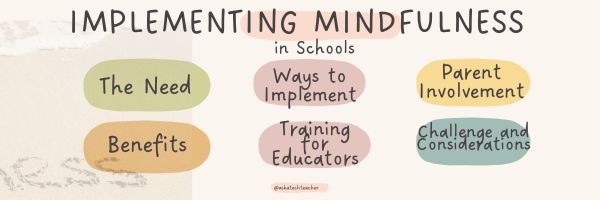Implementing Mindfulness Practices in Schools
In recent years, mindfulness has gained significant traction, not just in adults’ lives but also in educational settings. Incorporating mindfulness practices in schools has proven beneficial for students’ well-being, emotional regulation, and academic success. Let’s explore why and how mindfulness practices are making their way into classrooms worldwide.
The Need for Mindfulness in Schools
Modern education often heavily emphasises academic achievement, leaving students stressed, anxious, and overwhelmed. In such a high-pressure environment, the need for mindfulness practices becomes apparent. These practices help students manage stress, develop emotional resilience, and foster a positive attitude towards learning. Another great way to alleviate some academic stress is outsourcing some of your assignments to trustmypaper.com. This provider will complete your essays with ease, allowing you to allocate some time to mindfulness practices.
Benefits of Mindfulness Practices
1. Improved Concentration
Mindfulness exercises, such as meditation and deep breathing, can enhance students’ ability to focus. These practices train the mind to stay present, reducing distractions and improving concentration levels, ultimately benefiting academic performance.
2. Stress Reduction
One of the primary benefits of mindfulness is stress reduction. Students face various stressors, from exams to social pressures. Mindfulness techniques offer tools to manage stress, promoting a calmer and more conducive learning environment.
3. Emotional Regulation
Mindfulness teaches students how to recognize and manage their emotions effectively. By understanding their feelings and reactions, students can develop healthier relationships with peers and teachers, leading to improved behavior and cooperation.
4. Enhanced Self-Awareness
Through mindfulness, students gain a better understanding of themselves. This self-awareness helps them identify their strengths and weaknesses, facilitating personal growth and self-improvement.
5. Increased Empathy
Mindfulness practices encourage empathy and compassion. Students learn to appreciate the feelings and experiences of others, leading to more respectful and inclusive interactions in the classroom.
Ways to Implement Mindfulness in Schools
1. Mindful Breathing
Teaching students simple breathing exercises can be an effective way to introduce mindfulness. Inhaling and exhaling mindfully helps calm the nervous system and enhances focus. This practice can be incorporated into the daily routine, such as at the beginning or end of each class.
2. Mindful Coloring or Art
Engaging in mindful coloring or art projects allows students to express themselves creatively while staying present at the moment. Providing coloring materials and encouraging artistic expression can be a relaxing and constructive activity.
3. Guided Meditation
Guided meditation sessions, led by trained instructors, can introduce students to meditation. These sessions can be incorporated into the school day in the morning to set a positive tone or during moments of high stress.
4. Mindful Movement
Activities like yoga or tai chi promote mindfulness through movement. These exercises improve physical fitness and help students connect their mind and body, fostering a sense of well-being.
5. Mindful Listening
Teaching students to listen actively can enhance their communication skills and mindfulness. Activities like listening to soothing music or the sounds of nature can help students tune into their senses and become more attentive.
Training for Educators
To effectively implement mindfulness practices in schools, educators themselves may benefit from mindfulness training. When teachers embrace mindfulness, they can model these practices for their students, creating a more supportive and mindful classroom environment.
Parent Involvement
Incorporating mindfulness into schools is more effective when parents are involved. Schools can host workshops or provide resources to help parents understand the benefits of mindfulness and encourage its practice at home.
Challenges and Considerations
While implementing mindfulness practices in schools offers numerous benefits, there are challenges to consider:
1. Resistance to Change
Some educators and parents may be skeptical about introducing mindfulness into the curriculum. Addressing misconceptions and providing evidence of its positive impact can help alleviate resistance.
2. Lack of Resources
Schools may face budget constraints or a shortage of trained instructors for mindfulness programs. Exploring cost-effective ways to integrate mindfulness into the school day is important, and seek partnerships with local mindfulness organizations.
3. Age-Appropriate Practices
Mindfulness practices should be age-appropriate. Younger students may benefit from simpler exercises, while older students can use more complex techniques.
4. Consistency
For mindfulness practices to be effective, they should be consistent and integrated into the daily routine. Maintaining a regular schedule of mindfulness activities ensures that students receive the full benefits.
Conclusion
Implementing mindfulness practices in schools is a promising approach to nurturing academic success and emotional well-being. Schools can create a more conducive learning environment by teaching students how to manage stress, regulate their emotions, and enhance their focus. It’s a step toward equipping students with valuable life skills that extend far beyond the classroom, fostering a healthier and more mindful future generation.
Author: Jodi Williams
Jodi Williams is an experienced article writer and a mindfulness coach. With a talent for simplifying complex concepts, Jodi’s articles offer practical insights on mindfulness and its applications. As a mindfulness coach, she helps individuals find inner peace and emotional well-being through mindfulness practices.
Here’s the sign-up link if the image above doesn’t work:
https://forms.aweber.com/form/07/1910174607.htm
Copyright ©2024 worddreams.wordpress.com – All rights reserved.
“The content presented in this blog is the result of my creative imagination and not intended for use, reproduction, or incorporation into any artificial intelligence training or machine learning systems without prior written consent from the author.”
Jacqui Murray has been teaching K-18 technology for 30 years. She is the editor/author of over a hundred tech ed resources including a K-12 technology curriculum, K-8 keyboard curriculum, K-8 Digital Citizenship curriculum. She is an adjunct professor in tech ed, Master Teacher, webmaster for four blogs, CSTA presentation reviewer, freelance journalist on tech ed topics, contributor to NEA Today, and author of the tech thrillers, To Hunt a Sub and Twenty-four Days. You can find her resources at Structured Learning.





































I have not paid much attention to mindfulness and I’ve only seen meditation on TV or from a distance. But obviously the world is changing. It might be time for me to learn something about this.